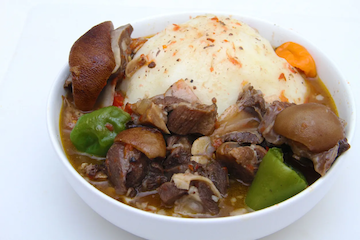
Fufu. A staple food widely consumed across West and Central Africa, known for its dough-like consistency and versatility as a base for various soups and stews. It is made by boiling starchy vegetables such as cassava, yams, or plantains, and then pounding them into a smooth, stretchy dough.
Fufu is often served as an accompaniment to traditional dishes like egusi, okra, or ogbono soups, and is typically eaten by hand, with diners pinching off small portions to dip into the accompanying sauce.
Origins and Cultural Significance
Fufu has deep roots in African culinary traditions and is a symbol of communal eating and togetherness in many cultures. Its preparation and consumption are often tied to social gatherings, where the pounding process can be a shared activity. The dish’s origins are ancient, with variations found across different regions, reflecting local ingredients and customs.
Regional Variations
The ingredients used to make fufu vary by region:
- Nigeria: Fufu is commonly made from cassava, though yam-based versions, such as “pounded yam” (iyan), are also popular, especially among the Yoruba people.
- Ghana: Fufu is often made from plantains or yams, or a combination of both.
- Other Regions: Some areas use a mix of cassava, yams, or cocoyams, depending on local availability and preference.
Preparation
The preparation of fufu is labor-intensive and involves several steps:
- Boiling: The starchy vegetables (cassava, yams, or plantains) are peeled and boiled until soft.
- Pounding: The boiled vegetables are then pounded in a mortar and pestle until they achieve a smooth, elastic consistency. This process can be communal, with multiple people taking turns to pound the mixture.
- Shaping: Once the desired texture is reached, the fufu is shaped into a ball or mound and served warm.
In modern times, some households use pre-packaged fufu flour to simplify the process, though traditional pounding remains common in many areas.
Consumption
Fufu is typically eaten with soups or stews, which are rich in flavor and nutrients. To eat fufu:
- A small portion is pinched off with the fingers (traditionally the right hand).
- This piece is then dipped into the accompanying soup or stew.
- It is customary to swallow fufu without chewing, as its smooth texture allows for easy consumption.
Nutritional Information
Fufu is primarily a source of carbohydrates, providing energy through its starchy base. However, it is low in protein, vitamins, and minerals, making it important to pair it with nutrient-dense soups or stews that include vegetables, meats, or fish. While fufu is calorie-dense, its nutritional value can be enhanced by the variety of ingredients in the accompanying dishes.
Fufu remains a beloved and essential part of African cuisine, celebrated for its cultural significance and its role in bringing people together around the table.